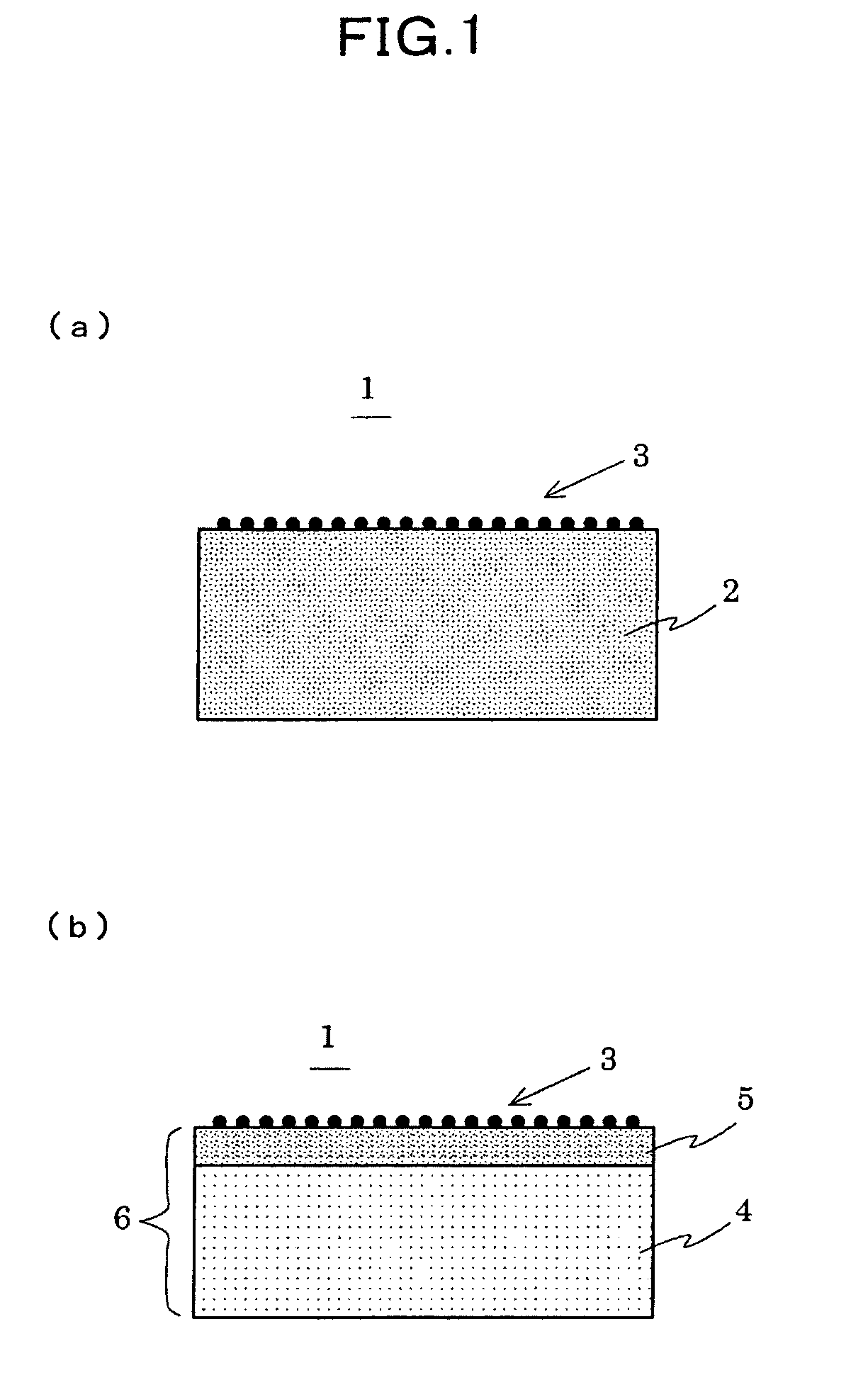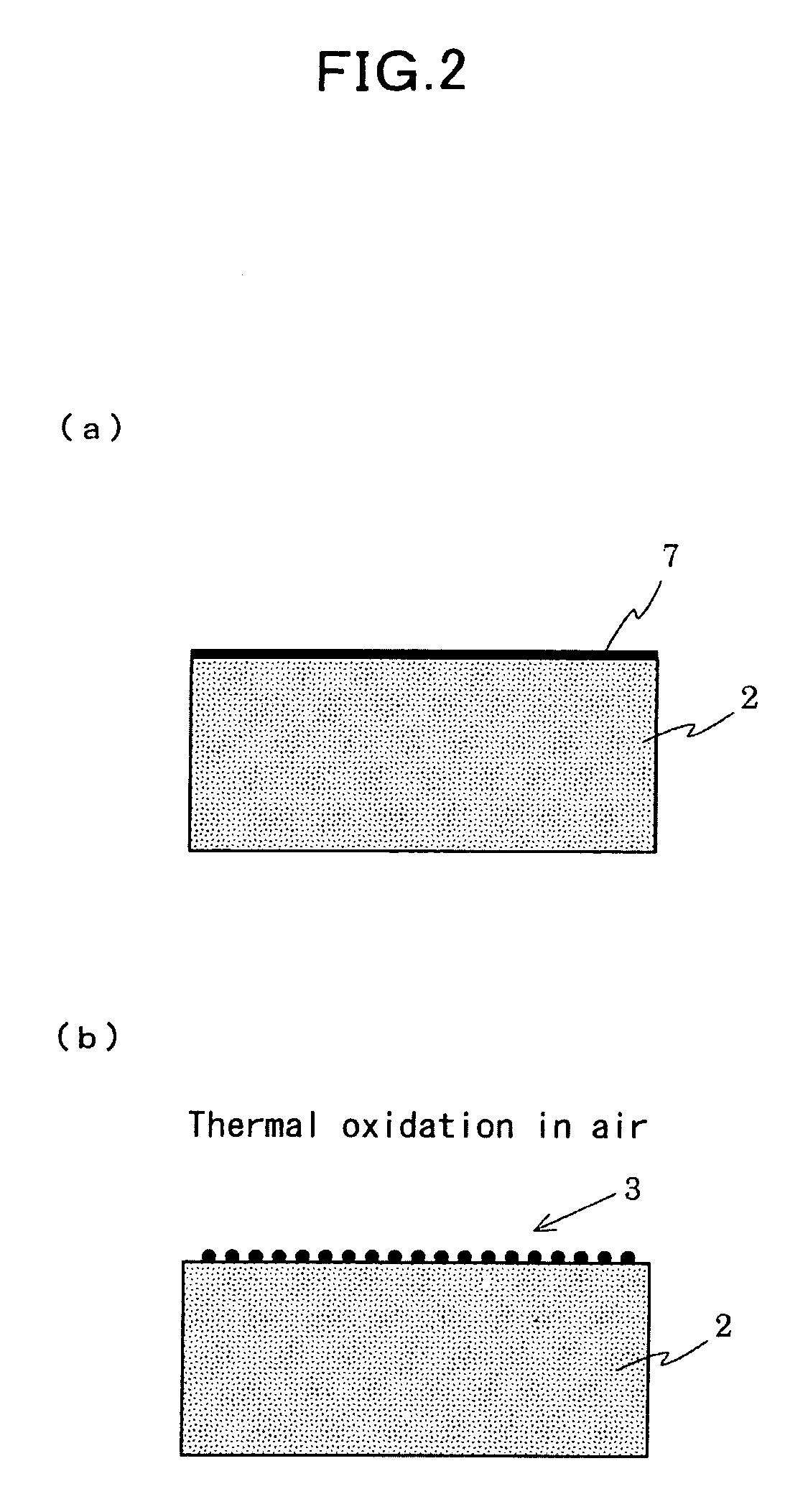Carbon nanotubes, substrate and electron emission device with such carbon nanotubes and carbon nanotube synthesizing substrate as well as methods of and apparatus for making them
a carbon nanotube and electron emission technology, which is applied in the manufacture of electrode systems, metal/metal-oxide/metal-hydroxide catalysts, electric discharge tubes/lamps, etc., can solve the problems of inability to synthesize carbon nanotubes randomly aligned and then mechanically, and no reproducible method, etc., to achieve good electron emission efficiency, improve the effect of electron emission efficiency and good crystal quality
- Summary
- Abstract
- Description
- Claims
- Application Information
AI Technical Summary
Benefits of technology
Problems solved by technology
Method used
Image
Examples
example 1
[0131]Mention is next made of Example 1.
[0132]As the base substrate, a n-type Si (100) oriented substrate (having a specific resistance of 0.0026 Ω·cm and a size of 7×22×0.5 mm) was used.
[0133]Initially, a cobalt thin film was deposited onto this substrate to a thickness of about 6 nm by magnetron sputtering and the substrate was then thermally oxidized in air at 900° C. for 10 minutes.
[0134]Then, in the apparatus shown in FIG. 7 carbon nanotubes were synthesized thereon by solid-liquid interfacial contact cracking in organic liquid in the apparatus as shown in FIG. 7.
[0135]Synthesis conditions used for solid-liquid interfacial contact cracking in an organic liquid are as follows:
[0136]Source organic liquid: methanol (purity of 99.9% and boiling point of 64.7° C.);
[0137]Synthesis temperature: 600° C.; and
[0138]Synthesis time: 5 minutes.
[0139]FIG. 4 is a chart illustrating X-ray photoelectron spectra for a thin film of cobalt before heat treatment in air at 900° C. for 10 minutes and...
example 2
[0151]Example 2 on a method of synthesizing carbon nanotubes in accordance with the present invention will be mentioned.
[0152]First, a cobalt thin film of 5 nm was deposited on a conductive silicon substrate by sputtering a cobalt target in an argon (Ar) atmosphere of 7 Pa with a discharge current of 35 mA for 3 minutes.
[0153]Then, the substrate was thermally oxidized to make a silicon conductive substrate carrying ultra-fine particles of cobalt oxide. The conditions for thermal oxidation were 900° C. and 15 minutes of heating by current passage in air. This thermal oxidation step was carried out in a way as mentioned in connection with FIG. 2 and is characterized in that in making densely aligned and highly oriented carbon nanotubes synthesizing substrate, a cobalt thin film deposited on a silicon or diamond substrate or a cobalt thin film deposited on a substrate comprising a glass, semiconductor, metal or oxide substrate and a silicon or diamond film formed thereon is thermally o...
example 3
[0162]Example 3 on an electron emission device of the present invention will be mentioned next.
[0163]An electron emission device using carbon nanotubes made in the Example of the carbon nanotube synthesizing according to the method of the present invention and an electron emission device using carbon nanotubes according to the conventional method were compared on their electron emission efficiencies.
[0164]FIG. 9 is a diagram illustrating the structure of a device and a measuring circuit used in the measurement of electron emission efficiency. A conductive Si substrate 21 having carbon nanotubes 20 grown thereon was opposed via a spacer 22 to a glass substrate 23 having a transparent ITO (indium-tin-oxide film) electrode 23a vapor deposited thereon. And, with a voltage applied between the substrate 21 and the transparent electrode 23a, electric current flown between them was measured as a function of applied voltage. The carbon nanotubes 20 had their apical ends spaced from the trans...
PUM
| Property | Measurement | Unit |
|---|---|---|
| temperature | aaaaa | aaaaa |
| temperature | aaaaa | aaaaa |
| time period | aaaaa | aaaaa |
Abstract
Description
Claims
Application Information
 Login to View More
Login to View More - R&D
- Intellectual Property
- Life Sciences
- Materials
- Tech Scout
- Unparalleled Data Quality
- Higher Quality Content
- 60% Fewer Hallucinations
Browse by: Latest US Patents, China's latest patents, Technical Efficacy Thesaurus, Application Domain, Technology Topic, Popular Technical Reports.
© 2025 PatSnap. All rights reserved.Legal|Privacy policy|Modern Slavery Act Transparency Statement|Sitemap|About US| Contact US: help@patsnap.com



